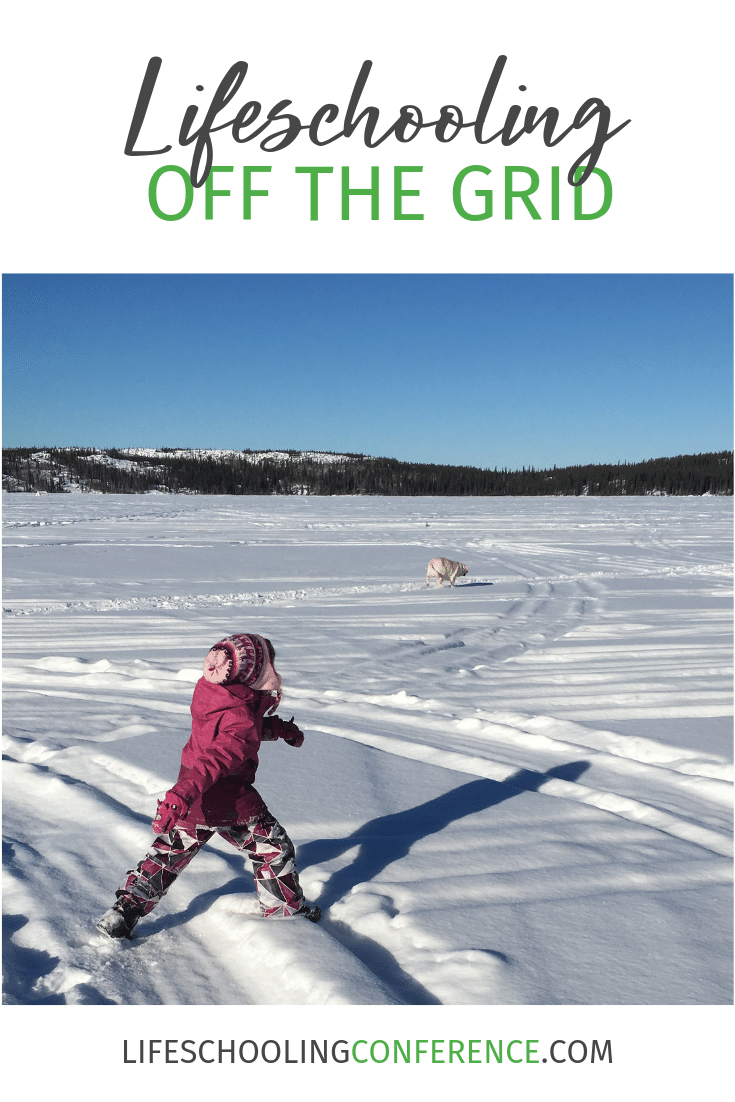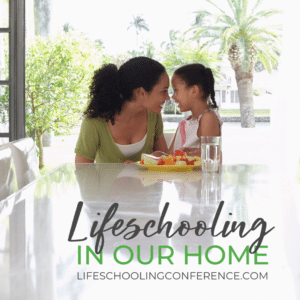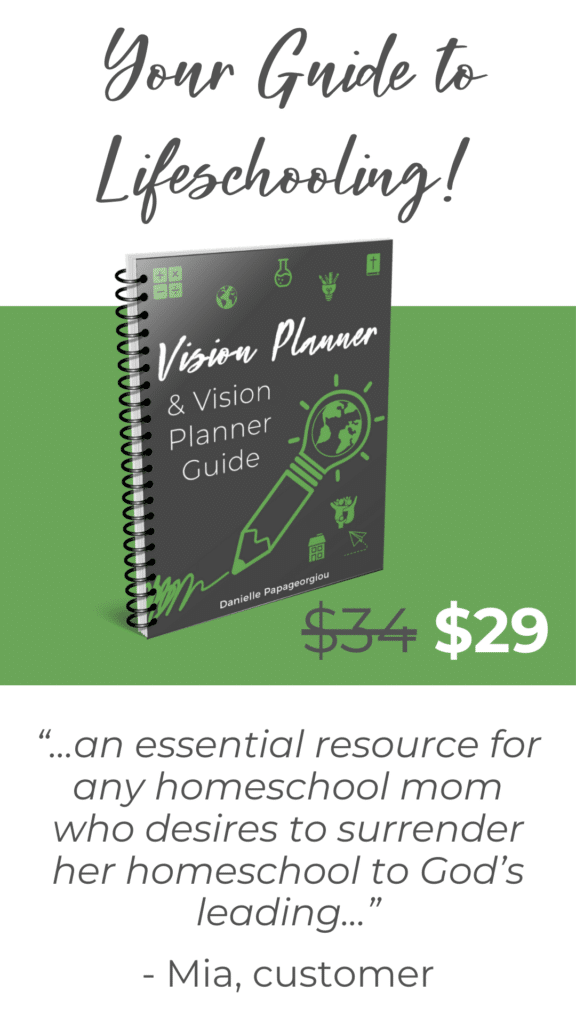When we moved from the Toronto suburbs to an off the grid home in Canada’s Northwest Territories in 2012, my husband and I knew we wanted to homestead and homeschool. At the time we had five mostly-grown children out on their own, and one young daughter still at home. By the summer of 2013, our seventh child was born.
While we expected the home education of our two youngest children to look pretty different from their older siblings, who all attended public schools in southern Ontario, we had no idea just how many lifeschooling opportunities would shape our homeschooling day – every day.
Here’s a small sampling of how our unique environment and lifestyle guide the lifeschooling we’re all enjoying.
Living Off The Grid
The term living off the grid can be confusing for some people, so I’ll clarify what I mean when I say that we live off the grid.
Our home isn’t connected to an electric power grid or water system. Instead, we obtain solar energy from panels on our roof. This works really well in the summer when we have almost 24 hours of continuous sunlight, and we have diesel generators for backup power in the winter.
Our house is quite remote as we live on a dirt trail that overlooks a large lake in Canada’s subarctic boreal forest. We’re about 400 kilometers (that’s 250 miles) south of the Arctic Circle. We have a huge wood stove for heating and some cooking, and also a propane boiler for those -40 degree days. Our water comes from the lake behind our home. This is where we live, homeschool and work.
Environmental Awareness is a Key Lifeschooling Lesson
As we live in the wilderness about a 40-minute drive to the only city in the area, it’s important for our girls to be very aware of their surroundings at all times. Not paying attention can have consequences – true, some are simply inconvenient, but others could prove deadly. So teaching mindfulness and awareness about our surroundings is an important part of our homeschool.
For example, the girls – who are now nine and almost-six, are acutely aware of the weather and how it impacts our activities. They know if it’s sunny out we’ll have lots of solar power to run the washing machine, and they’ll be hanging clothes out on the line to dry. We’ll also run the lake pump to bring up water into the house, or they’ll have a chance to run the vacuum cleaner.
In the winter, they’re always checking the outdoor temperature. If it’s colder than -30 Celsius (-22 Fahrenheit), they know they can get frostbite pretty quickly. And in the summer, which can be quite dry, they know to pay attention to the smell of smoke which can indicate a fast-moving wildfire, which is a very real threat in this area.
Where Book Learning and Real Life Consequences Meet
Living as close to nature as we do really brings home the science lessons and news stories we see on climate change and the impact it has on our environment and the species around us. After studying climate change and global warming in our science textbooks, the girls can see the impact all around us. For example, my younger daughter noticed the ice roads (roads across ice-covered lakes) used to travel north during the winter are closing earlier each year due to warmer weather arriving earlier.
Being Prepared Every Day
One of the key ways our lifeschooling lifestyle might differ from others is our emphasis on teaching preparedness and self-reliance in as many situations as possible. Not only are these important values in our family culture, they’re just plain sensible life skills for living in a remote environment. That said, the lessons of being prepared and having the skills to confidently handle yourself well apply in any environment and situation.
For example, something as simple as going for a family walk means each girl should bring a backpack with a child’s wilderness kit. The items change depending on the season. And some of them will be the same as those in the backpack of any child out for an afternoon in a city or suburb. Water bottle, sunblock, snack, sun hat. Yet in our case, each girl also has a bug suit (our mosquitoes are HUGE), a whistle (it makes a lot of noise in case they get separated from us), a small first aid kit, a foil emergency blanket, a signalling mirror, and a bear bell (lots of black bears here).
My older daughter has been practicing navigation and compass skills. She’ll get a Swiss army knife with Faro rods (fire starters) in a few months, once she’s mastered safe fire starting practices. Being prepared and having self-reliance skills not only helps build confidence, in our world, but it can also be the difference between life and death.
Self-Reliance and Old-Fashioned Skills
Some of the other ways we encourage self-reliance as part of lifeschooling here are through activities such as
- foraging for medicinal plants, wild berries, leaves, roots, and shoots
- indoor and outdoor gardening (we’re currently building a greenhouse with windows salvaged from the local dump)
- fishing – winter and summer
- canning and preserving
- baking and wood stove cooking from scratch
- various handicrafts such as knitting, crocheting, weaving, and sewing
I’m always looking for ways to encourage the girls to “do it yourself.” And as they try each new activity, they’re getting a chance to discover a new gift or talent. Since our days are our own, when something catches their attention they have time to pursue it. We’ve spent long summer days fishing and learning about all the local fish. We’ve also spent long winter days weaving on hand looms while listening to audiobooks. The freedom to pursue their interests so precious to us.
Hands-On Learning, Logical Thinking & Problem-Solving
The opportunities for hands-on learning have been such a blessing in our off-grid homeschool. Our remote location means repair-people are few and far between. Shipping costs are high, and supplies can be hard to come by unless we make the 16-hour drive down to Edmonton, Alberta.
Each time we have to build or fix something ourselves, the girls get a hands-on first-hand look at real-life problem-solving. They’ve seen their father install a new generator to keep our boiler running in extremely cold weather. They’ve helped set up our indoor plant lights and system so we’d have fresh herbs and lettuce all winter.
Entrepreneurship & Independence in Any Environment
We’re very fortunate that although we live what may seem like an unusual life by many of today’s standards, we also have good access to technology and modern amenities. These are important tools for exploring entrepreneurial projects and passions.
For example, our wireless internet hub helps us run our website and my financial content creation business. My older daughter is learning how to navigate the internet and use graphics software to help in our business. And soon the girls will start selling their handicrafts at the farmer’s market in town.
For our family, lifeschooling means learning how to navigate any environment by being aware, prepared, and knowing how to problem-solve, and living off the grid in Canada’s far north gives us new opportunities to do so each and every day.
- Lifeschooling Off The Grid - June 21, 2019






2 Comments
I love Nature Anatomy. Its illustrations are lovely, and the info is a great springboard for rabbit trails!
Had the pleasure of opening my email this morning and seeing this article by Sarita. We also enjoy lifeschooling off grid in Canada’s Arctic along side Sarita and her beautiful family just a ways down the lake.